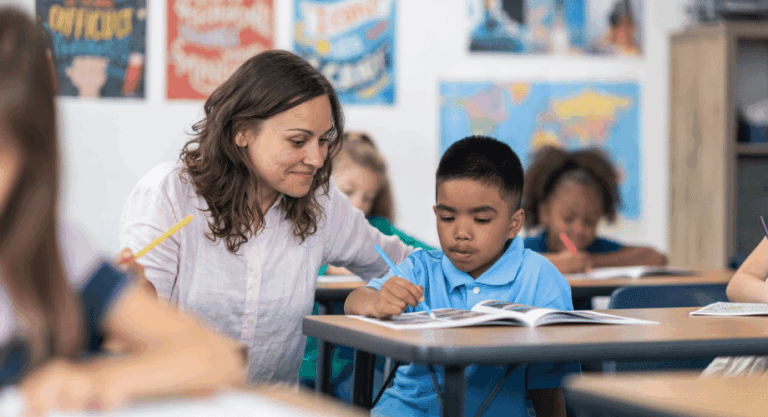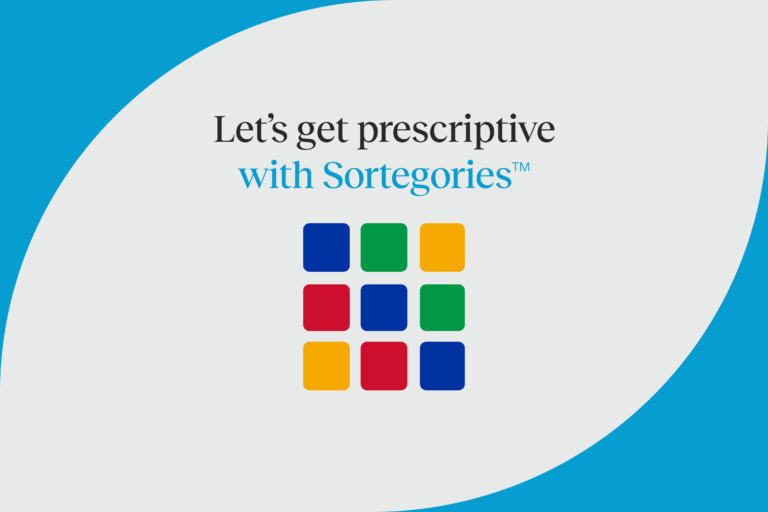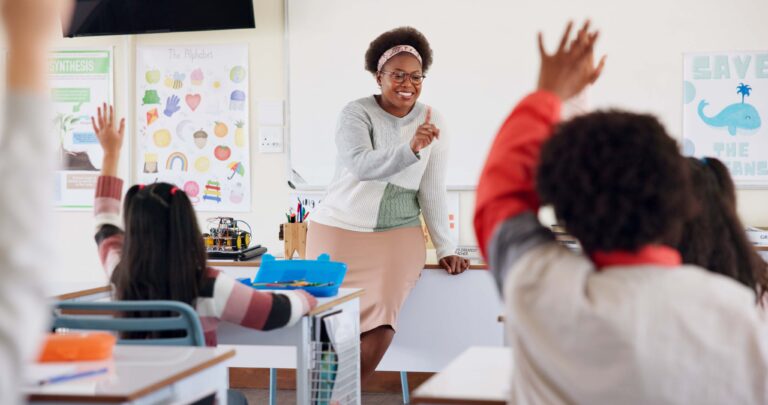Preventing summer learning loss: Strategies for teachers and parents
Summer presents challenges and opportunities for literacy learning for students of all ages. In this blog post, we examine the research over several decades on summer learning loss to find where there is consensus. We offer several strategies for educators and parents to leverage the opportunities for learning that summer presents. We encourage teachers to adopt a year-round prevention mindset, and common language and routines across grades and tiers. And we look at success stories from three school districts that have implemented structured literacy and seen students sustain learning through the summer and into the next school year. We offer both teachers and parents a range of resources from webinars to books to help them sustain and grow their own learning.

Strategies for reducing summer learning loss
First, definitions
Summer slide…you’ve probably heard those two words together. Also referred to as summer learning loss, summer setback, summer slump, the term is commonly used in referring to a drop in student performance between spring and fall. Recently, researchers have suggested the terms summer stagnation or slowdown may be more accurate descriptions for what they observe.
What does the research say?
For several decades now, researchers have studied how and why some students lose some of the academic gains made during the previous school year over the summer break. Barbara Heyns did one of the earliest analyses of summer learning gains and losses and published the results of her findings in the book Summer Learning and the Effects of Schooling (Academic Press, 1978). One of Heyn’s central findings was: Children learn more when they are in school than when they are not.
In 1996, Cooper, Nye, Charlton, Lindsay and Greathouse published an oft-cited meta-analysis of the educational research. They reviewed 39 studies, which indicated that achievement test scores declined over the summer. Their conclusion focused on the difference in opportunities in summer, and the income differences that may have contributed to differences in opportunities to practice and learn.
By 2003, research suggested that summer learning loss may not be as widespread, uniform, or pronounced as earlier research reported. Allington and McGill-Franzen emphasized the complexity of measuring learning loss, calling attention to differences in assessment tools and timing of assessments that can lead to varying conclusions. Their analysis suggested that some of the studies examined overestimated the severity of summer learning loss due to different methodologies.
Fast forward to 2019: Paul T. von Hippel, associate professor in the LBJ School of Public Affairs at the University of Texas at Austin summarizes his research in the fall 2019 issue of Education Next in a post titled, Is Summer Learning Loss Real? He wrote about summer learning:
“There is one result that replicates consistently across every test that I’ve ever looked at. It’s so obvious that it’s easy to overlook, but it’s still important: nearly all children, no matter how advantaged, learn much more slowly during summer vacations than they do during the school years.”
He underscores the opportunity this presents: “That means that every summer offers children who are behind a chance to catch up. In other words, even if gaps don’t grow much during summer vacations, summer vacations still offer a chance to shrink them.”
In summary, current research agrees on these points:
- Summer learning loss is complicated to measure accurately.
- Learning rates are more variable during the summer than during the school year.
- A gap in summer learning opportunities can contribute to summer reading stagnation.
- Summer offers an opportunity to shrink existing gaps and help kids who are lagging to catch up.
The impact of summer reading gaps
We know that reading is foundational to learning across subjects. The primary years of school are critically important in securing the foundational skills of reading. As students advance into the intermediate years there is an expectation that they will be able to comprehend increasingly sophisticated grade-level text across multiple subject areas. Starting the new school year with decreased reading proficiency due to lack of practice, resources, or opportunity can lead to a widening achievement gap, lower academic performance, and reduced motivation and engagement at school. Consistent engagement and success with reading is critical for building the literacy and critical thinking skills necessary for success as students advance across the grades.
Strategies to prevent increased learning gaps
Although measuring summer learning loss is complicated, one thing is very clear—summer offers an opportunity to shrink existing literacy gaps and help students who have fallen behind to catch up. Here are some essential strategies to help you support your students year-round.
For educators
Embrace a preventative approach in Tier 1
A foundational strategy is to ensure students are receiving explicit and systematic phonics instruction in a Tier 1 core program, leaving fewer children in need of intervention throughout the school year and in the summer.
Independent research in a Lexington, Nebraska school district by Learning Experience Design (LXD) Research for example concluded that rising 2nd graders using the Tier 1 95 Phonics Core Program™ in the 2021–2022 school year retained more information than they did the previous summer. Rising 3rd graders not only retained more information than the previous summer, but also scored higher at the start of 3rd grade than at the end of 2nd grade.
In Maryland, at the beginning of the 2022-2023 school year, Renee Hall, supervisor of reading K-5, and her colleagues at Wicomico County Public Schools in Maryland gave students the iReady diagnostic tests. They were impressed with results from their original, pilot elementary school in particular. “Students had made strong progress and did not even have the summer slide that we thought they may,” she said.
Use common language and routines across tiers
Move towards building an ecosystem approach that uses the same language across the district, grades, and tiers of instruction. This way, when kids change schools, grades, or move between tiers of instruction, they don’t have to learn new language and routines. They can pick right up where they left off.
For example, Stephanie Sanker, curriculum coordinator for elementary ELA at the Fort Zumwalt School District in O’Fallon, Missouri describes the experience in her district after implementing the 95 Phonics Core Program for K-3 in the fall of 2021:
“When our students who had the 95 Percent Group program last year moved up to the next grade level this year, it was very easy for them to slip right back into the routines. They didn’t have to spend as much time at the beginning of the year as they did last year learning the structures for the lesson.”
According to an efficacy report by LXD Research, “Educators from this district continued to share stories with the research team after the first year of the study ended. They said that it was clear during summer school which students had received the 95 Phonics Core Program and which students had not.”
And it gets even better. These students are in a strong position for the next school year. The report continues: “At the start of the year, teachers shared that they had never seen their students so prepared for the start of school. The student assessment data validated what the teachers observed firsthand in their own classrooms. The data show the first year of the 95 Phonics Core Program had a positive, significant impact on student achievement that extended past the summer and into the new school year.”
Continue learning throughout summer
Provide a summer learning opportunity for students to sharpen foundational skills in phonics with lessons from an explicit and sequential program, designed specifically for summer school. It should reinforce and build upon student learning from the school year, providing consistent and engaging routines and instructional dialogue. Look specifically for a program based on the latest research with a seamless continuum of foundational skills to strengthen students’ grasp of the prior year’s phonics skills for use in whole class or small group instruction.
Support your own continual learning
Summer can be a great time to dive deeper into your professional learning on the science of reading. Listen to Emily Hanford’s podcasts (e.g., the nine-part Sold a Story series, or the earlier series Hard Words) or a recent lecture she’s given. Pick up Speech to Print: Language Essentials for Teachers (3rd Edition) by Dr. Louisa Moats. If you haven’t already, explore the neuroscience of reading with Language at the Speed of Sight: How We Read, Why So Many Can’t, and What Can Be Done About It by cognitive neuroscientist Mark Seidenberg, or Reading in the Brain: The New Science of How We Read by cognitive neuroscientist Stanislas Dehaene.
Explore professional development opportunities offered by 95 Percent Group—especially, the large collection of on-demand webinars and the Top 10 Tools™, a self-paced, 10-module online course.
Stay connected
Invite a colleague to be your summer learning partner. Decide on what you’d like to do this summer (listen to podcast series, read a particular book, watch a webinar), and do it together. Choose attainable goals. Discuss what you’re learning (try once a week for starters and adjust as needed), either online, or over coffee or a walk in person, and help each other stay accountable to your summer goals. Have fun learning together.
For parents and caregivers
Parents and caregivers can take many approaches to help their children and teens to enjoy reading and retain what they’ve learned over the summer. Here are ideas for you.
Make friends with your library.
Many libraries have storytime for younger children. For older kids, learn how to use WorldCat together to search for books and locate them in libraries near you.
For older students, encourage them to consider starting a book club.
Do they have a favorite graphic novel? What’s that book they’ve really been wanting to read but never have the time? Talk them through how they might go about organizing a book club with friends.
Pay attention to what you are modeling.
Do your kids see you reading? What genres do you read most of the time? How can you stretch yourself? Consider reading Maryanne Wolf’s Reader, Come Home: The Reading Brain in a Digital World. Follow School Library Journal (@sljournal) on Instagram and explore their book reviews. Finding that space in our busy schedules can be a challenge, but give yourself the luxury of time to fully engage in reading.
Make conversations with your family about what you are reading a regular part of your summer.
For example, talk about the most exciting thing you read in the past week, or the age-appropriate scariest thing you read and why.
Have fun while learning together.
Seek out resources like the Spot the Troll game created by the Clemson University Media Forensics Hub (for older kids). Challenge each other to play and then discuss what you learned about how to identify fake social media accounts.
Keep learning yourself.
Here are suggestions for parents and caregivers (and teachers, too!):
- Get to know The Reading League and explore the resources in their new Compass.
- Check out Reading Rockets.
- Straight Talk About Reading: How Parents Can Make a Difference During the Early Years by Susan L. Hall and Louisa C. Moats, EdD.
- Younger kids? How Your Brain Learns to Read by Denise Eide, illustrated by Ingrid Hess (excellent children’s book)
In conclusion
Summer can be a time of opportunity—to shrink existing gaps and help kids to catch up. It can be a time for kids to explore new ideas, expand how they think about themselves, and build their reading identities for life. Embracing a preventative approach in Tier 1 instruction throughout the school year and applying common language and routines across all grades and tiers will help students pick right up where they left off when they begin again in the fall. Teachers of summer programs, and parents and caregivers—keep balance and fun in mind as you encourage a range of pleasurable reading activities throughout the summer months. And make your own learning visible so you can model that learning happens year-round and life-long.
95 Percent Group products
Classroom-ready, evidence-based phonics instruction for your literacy block. In 30 minutes a day, the program builds critical phonics skills through explicit instruction to develop strong readers, K-5.
95 Phonics Booster Bundle™: Summer School Edition
Effectively increased students’ phonics skills in a four-week summer program, helping close phonics gaps before the start of school. This program presents a seamless continuum of foundational skills to strengthen students’ grasp of the prior year’s phonics skills in 25 lessons designed for 30-45 minute blocks, for use in whole class or small group instruction.
Read the independent research here.
Contact a literacy expert for more information.
References
Cooper, H., Nye, B., Charlton, K., Lindsay, J., & Greathouse, S. (1996). “The effects of summer vacation on achievement test scores: A narrative and meta-analytic review.” Review of Educational Research.
Allington, R. L., & McGill-Franzen, A. (2003). “The Impact of Summer Setback on the Reading Achievement Gap.” Phi Delta Kappan.
Kuhfeld, M. (2019). Surprising new evidence on summer learning loss. Phi Delta Kappan, 101(1), 25-29. https://doi.org/10.1177/0031721719871560
Von Hippel, P.T. (2019). Is Summer Learning Loss Real? How I lost faith in one of education research’s classic results. Education Next, 9-14.
Kuhfeld, M., McEachin, A. (2021). “Summer learning loss: What we know and what we’re learning.” NWEA.
Pappas, Stephanie (2023). School’s Out. Should You Worry about the ‘Summer Slide’? Scientific American, July 10, 2023



